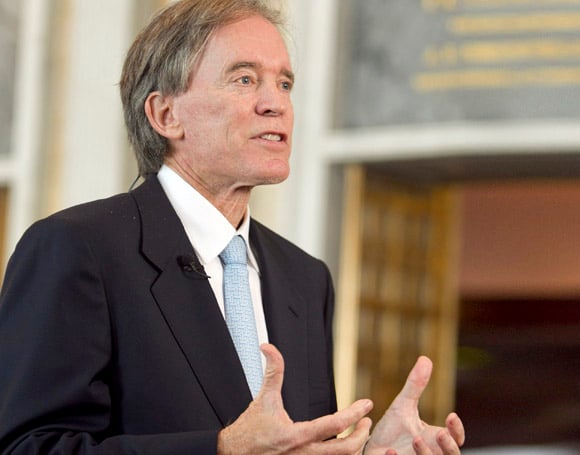Meanwhile, manager of world's biggest bond fund reduces exposure to government debt
Bill Gross, who runs the world's biggest bond fund at Pacific Investment Management Co., reduced holdings of government-related debt to the lowest level since July 2009 and added mortgage-related assets in October.
The $256 billion Total Return Fund's investment in government-related securities fell to 28 percent of assets from 33 percent the previous month, according to data published yesterday on the website of the the Newport Beach, California company. The fund boosted mortgages assets to 39 percent, the highest level since July 2009, from 28 percent. Pimco doesn't comment directly on monthly changes in its portfolio holdings.
Gross, who reduced holdings of government debt for a fourth month, said in October that asset purchases by the Federal Reserve will probably signify the end of the 30-year rally in bonds. Treasuries completed their steepest two-day decline since January 2009 yesterday after a group of economists and former government officials warned the central bank's plan to snap up $600 billion of government debt through June will lead to higher prices in the economy.
“The planned asset purchases risk currency debasement and inflation, and we do not think they will achieve the Fed's objective of promoting employment,” the group wrote in a note to be published this week in the Wall Street Journal and the New York Times.
John Taylor, the Stanford University professor who created a monetary-policy formula used by the Fed, is among the group of 23 who signed the open letter to central bank Chairman Ben S. Bernanke. The Fed is scheduled to buy Treasuries every day this week under the program.
Bonds have limited room to gain, according to Gross.
“Check writing in the trillions is not a bondholder's friend,” Gross wrote in a monthly investment outlook on Pimco's website on Oct. 27. “It is in fact inflationary, and, if truth be told, somewhat of a Ponzi scheme. It raises bond prices to create the illusion of high annual returns, but ultimately it reaches a dead end where those prices can no longer go up.”
Yields on 10-year notes increased 31 basis points over the previous two trading days.
Treasuries have dropped 1.4 percent in November, extending a 0.2 percent slide in October, according to Bank of America Merrill Lynch data. Government securities haven't dropped for two straight months since they fell in April, May and June of 2009, when signs of economic improvement sapped demand for the relative safety of U.S. debt.
Ten-year rates declined five basis points today to 2.91 percent as of 2:24 p.m. in Tokyo, according to data compiled by Bloomberg. The price of the 2.625 percent security due in November 2020 rose 13/32, or $4.06 per $1,000 face amount, to 97 1/2.
The difference between yields on U.S. 10-year notes and Treasury Inflation Protected Securities, a gauge of trader expectations for consumer prices over the life of the securities, has widened to 2.09 percentage points from this year's low of 1.47 percentage points in August. The latest figure matches the five-year average.
Pimco's U.S. government-related debt category can include conventional and inflation-linked Treasuries, agency debt, interest-rate derivatives, Treasury futures and options and bank debt backed by the Federal Deposit Insurance Corp., according to the company's website.
Under what Pimco calls the “new normal,” investors should expect lower-than-average historical returns with heightened regulation, lower consumption, slower growth and a shrinking global role for the U.S. economy. Adapting to that outlook change, Pimco began offering equity funds in April.
The Total Return Fund's high-yield holdings rose by 1 percentage point to 5 percent in October, and non-U.S. developed debt increased 1 percentage point to 7 percent. Pimco reduced its net cash-and-equivalent position to negative 11 percent from negative 3 percent. It can have a so-called negative position by using derivatives, futures or by shorting.
Derivatives are financial obligations whose value is derived from an underlying asset such as debt, stocks or commodities. Futures are agreements to buy or sell assets at a later specific price and date.
Shorting is borrowing and selling an asset in anticipation of making a profit by buying it back after its price has fallen.
The fund has returned 10.2 percent in the past year, beating 72 percent of its peers, according to data compiled by Bloomberg. It lost 0.7 percent over the past month. Pimco, a unit of the Munich-based insurer Allianz SE, managed $1.236 trillion of assets as of September.







